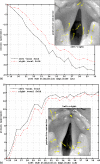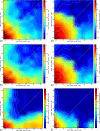Graded activation of the intrinsic laryngeal muscles for vocal fold posturing
- PMID: 20369979
- PMCID: PMC2856174
- DOI: 10.1121/1.3310274
Graded activation of the intrinsic laryngeal muscles for vocal fold posturing
Abstract
Previous investigations using in vivo models to study the role of intrinsic laryngeal muscles in phonation have used neuromuscular stimulation to study voice parameters. However, these studies used coarse stimulation techniques using limited levels of neuromuscular stimulation. In the current investigation, a technique for fine control of laryngeal posturing was developed using graded stimulation of the laryngeal nerves. Vocal fold strain history to graded stimulation and a methodology for establishing symmetric laryngeal activation is presented. This methodology has immediate applications for the study of laryngeal paralysis and paresis, as well as general questions of neuromuscular control of the larynx.
Figures



References
-
- Choi, H. S., Berke, G. S., Ye, M., and Kreiman, J. (1993a). “Function of the thyroarytenoid muscle in a canine laryngeal model,” Ann. Otol. Rhinol. Laryngol. AORHA2 102, 769–776. - PubMed
-
- Choi, H. S., Berke, G. S., Ye, M., and Kreiman, J. (1993b). “Function of the posterior cricoarytenoid muscle in phonation: In vivo laryngeal model,” Otolaryngol.-Head Neck Surg. OHNSDL 109, 1043–1051. - PubMed
-
- Choi, H. S., Ye, M., and Berke, G. S. (1995). “Function of the interarytenoid (IA) muscle in phonation: In vivo laryngeal model,” Yonsei Med. J. YOMJA9 36, 58–67. - PubMed
Publication types
MeSH terms
Grants and funding
LinkOut - more resources
Full Text Sources

